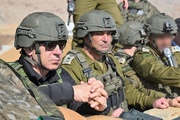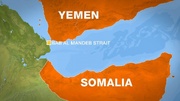-
 2025-12-29 21:36
2025-12-29 21:36
By Staff Writer
Weizmann still in Iran's sights: eyes after missiles
Tehran Times receives recent on-the-ground photos of highly-protected site damaged during Iran's June strikes
TEHRAN – A review of Hebrew media reports in recent weeks shows that even the regime’s own outlets are uncertain about how to address what appears to be a large-scale Iranian infiltration of Israel’s most sensitive military and security sites.
-

By Garsha Vazirian
Six countries, three seas, one voracious war machine
A year of Tel Aviv’s fear doctrine—sovereignty dismantled across six nations, maritime terror targeting humanitarian aid
TEHRAN – In 2025, Israel acted as a borderless war machine, unleashing over 10,631 military attacks across six nations—Palestine, Lebanon, Syria, Iran, Yemen, and Qatar—while extending its brutality to maritime terrorism against aid ships in the waters of Malta, Greece, and Tunisia.
-

By Sondoss Al Asaad
Yemen and mirage of Somaliland: Sovereignty, deterrence, and battle over the Red Sea
BEIRUT—The renewed focus on the so-called “Somaliland” is not an isolated African issue but a deliberate geopolitical maneuver tied to the security of the Red Sea and the balance of power in West Asia.
-

By staff writer
Al-Houthi’s warning: A red line for Israel in Somaliland
TEHRAN – The leader of Yemen’s Ansarullah has declared that any Israeli presence in Somaliland will be treated as a “military target,” framing Israel’s recent recognition of the breakaway region as an act of aggression against Somalia, Yemen, and the wider Red Sea corridor. Abdul-Malik al-Houthi’s remarks underscore the seriousness with which Yemen’s resistance movement views Tel Aviv’s latest geopolitical maneuver, and highlight the broader struggle over sovereignty and control in one of the world’s most strategic maritime zones.
-

Talks with US ‘not realistic’ without respect for norms, says foreign ministry
TEHRAN – Iran says the circumstances are not yet ripe for launching negotiations with the United States despite Iran’s commitment to diplomacy, Foreign Ministry spokesperson Esmaeil Baqaei said on Monday, amid reports that Iraq has offered to mediate between Tehran and Washington.
-

Top female entrepreneurs honored
TEHRAN – During the third national congress on Iranian women, 60 of the most successful women entrepreneurs, who have played a key role in the country's social and economic development, were honored.
Politics
-

Russia says Tehran showing 'maximum restraint' despite western provocations
TEHRAN – Sergey Lavrov, in an interview with Russian media, said that Iran has shown the highest level of restraint and readiness for dialogue in response to all Western provocations.
-

Araghchi urges regional cooperation on Yemen in calls with UAE, Saudi Arabia
TEHRAN – Iranian Foreign Minister Abbas Araghchi held separate phone calls with his counterparts in the United Arab Emirates and Saudi Arabia to discuss bilateral ties and regional developments, especially the conflict in Yemen.
-

If Iran had sought nuclear arms, Trump ‘gave the best pretext through war’: Zarif
TEHRAN – Iran’s former foreign minister and chief negotiator of the 2015 nuclear deal said on Monday that Tehran has never sought nuclear weapons, arguing that U.S. President Donald Trump’s attacks on Iran would have provided the clearest justification if it had.
Sports
-

Ricardo Sa Pinto to remain Esteghlal head coach
TEHRAN - Ricardo Sa Pinto will remain as head coach of Esteghlal after the club’s board of directors decided to give the Portuguese manager more time despite recent poor results.
-

Amiri hungry for more success in wheelchair basketball
TEHRAN - Roghayeh Amiri, Iran’s national women’s wheelchair basketball team forward, expressed hope that she can continue to achieve honors with the national team in upcoming events.
-

Nouri elected as president of National University Sports Federation of Iran
TEHRAN – Reza Nouri was elected as new president of the National University Sports Federation of Iran on Monday.
Culture
-

Tehran concert to honor Martyr Soleimani with symphonic tribute
TEHRAN- Tehran Symphony Orchestra, conducted by Nasir Heidarian, will perform the concert “Iran-Mard” at Tehran’s Vahdat Hall on Tuesday, in memory of Martyr General Qassem Soleimani.
-

Head of ICRO Hojjatoleslam Imanipour meets Malaysian officials, thinkers, religious leaders
TEHRAN – The head of the Islamic Culture and Relations Organization (ICRO) made a visit to Malaysia with the aim of strengthening cultural diplomacy, engaging with elites and intellectuals, supporting Iranians living abroad, and expanding Quranic and cultural cooperation between the two countries.
-

Arasbaran Cultural Center screens “Caught Stealing”
TEHRAN- “Caught Stealing,” a 2025 black comedy film by prominent American filmmaker Darren Aronofsky, went on screen at the Arasbaran Cultural Center in Tehran on Sunday.
Economy
-

Iran, Turkey business groups seek to expand industrial, trade cooperation
TEHRAN – Business delegations from Turkey’s Van province and Iranian industrial representatives held talks in Tehran on ways to remove trade barriers and expand bilateral industrial and commercial cooperation, officials said.
-

Shrimp production increases 37%
TEHRAN- Iran Fisheries Organization (IFO) announced that shrimp production has reached 50,000 tons, a 37-percent increase compared to last year.
-

Iran's private sector eyes technical, engineering co-op with Indonesia
TEHRAN – Iran’s private sector is ready to participate in large-scale technical and engineering projects in Indonesia, the head of Iran Chamber of Commerce, Industries, Mines and Agriculture (ICCIMA) said, calling for closer cooperation between the chambers of commerce of the two countries to facilitate joint business activity.
Society
-

Health ministry underlines need to implement clean air law
TEHRAN – The deputy health minister, Alireza Raeisi, has urged the implementation of the clean air law as air pollution accounts for 57,000 deaths in the country annually.
-

UNODC, Russia hold training course for Iran's anti-narcotics police
TEHRAN – Iran's anti-narcotics police have attended a training course organized by the United Nations Office on Drugs and Crime (UNODC) in cooperation with the Siberian Law Institute of the Ministry of Internal Affairs of the Russian Federation.
-

Top female entrepreneurs honored
TEHRAN – During the third national congress on Iranian women, 60 of the most successful women entrepreneurs, who have played a key role in the country's social and economic development, were honored.
Tourism
-

Ilam province expands handicraft exports to Persian Gulf markets
TEHRAN - Iran’s western province of Ilam has begun exporting its handicrafts to the Persian Gulf littoral countries, marking a new phase in efforts to expand international markets for locally made products, a provincial official said on Sunday.
-

Cultural Heritage Ministry establishes AI department
TEHRAN – The Ministry of Cultural Heritage, Tourism and Handicrafts has established a new department dedicated to artificial intelligence (AI), aiming to integrate emerging technologies into its operations in a gradual, practical and goal-oriented manner.
-

Sightseeing along ancient spice route added to Iran’s tourism calendar
TEHRAN – Sightseeing tours along sections of the ancient spice route located in Iran have been officially added to the country’s tourism calendar, a move aimed at highlighting Iran’s historical role in regional and global trade networks, a local tourism official said on Sunday.
International
-

Six countries, three seas, one voracious war machine
TEHRAN – In 2025, Israel acted as a borderless war machine, unleashing over 10,631 military attacks across six nations—Palestine, Lebanon, Syria, Iran, Yemen, and Qatar—while extending its brutality to maritime terrorism against aid ships in the waters of Malta, Greece, and Tunisia.
-

Yemen and mirage of Somaliland: Sovereignty, deterrence, and battle over the Red Sea
BEIRUT—The renewed focus on the so-called “Somaliland” is not an isolated African issue but a deliberate geopolitical maneuver tied to the security of the Red Sea and the balance of power in West Asia.
-

Al-Houthi’s warning: A red line for Israel in Somaliland
TEHRAN – The leader of Yemen’s Ansarullah has declared that any Israeli presence in Somaliland will be treated as a “military target,” framing Israel’s recent recognition of the breakaway region as an act of aggression against Somalia, Yemen, and the wider Red Sea corridor. Abdul-Malik al-Houthi’s remarks underscore the seriousness with which Yemen’s resistance movement views Tel Aviv’s latest geopolitical maneuver, and highlight the broader struggle over sovereignty and control in one of the world’s most strategic maritime zones.
Video Comment
-

Ayatollah Khamenei’s vision of freedom and humanity discussed in intl. conference
-

Iran hosts SCO joint anti-terror drills
-

Holy Mary Metro Station marks interfaith unity in Tehran
-

Academics analyze social dimensions of Resistance in Tehran conference
-

Culture minister highlights year of progress in arts, global image enhancement
Most Viewed
-
Milestone in Iran with triple satellite launch
-
Is the UAE sailing Israel’s ship in the Gulf of Aden and the Red Sea?
-
Weizmann still in Iran's sights: eyes after missiles
-
US using Iraqi airspace to spy on Iran
-
Iran's path to orbit
-
Fanning the flames: How US arms sales destabilize Taiwan and violate China’s sovereignty
-
Major hack exposes Netanyahu’s chief aide in corruption scandal
-
Iran, Turkey stress parliamentary cooperation to boost bilateral ties
-
Yemen and mirage of Somaliland: Sovereignty, deterrence, and battle over the Red Sea
-
If Iran had sought nuclear arms, Trump ‘gave the best pretext through war’: Zarif
-
Six countries, three seas, one voracious war machine
-
Iran does not interfere in Baghdad’s affairs, says Iraqi PM
-
Iran's exports to China rise 3% in November
-
Collapse of the illusion of ‘absolute security’ in Tel Aviv’s calculations
-
Susa: Walking through one of the world’s oldest cities







